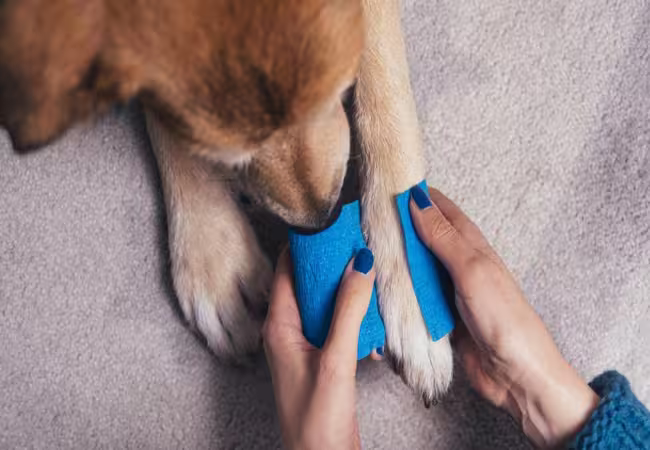Vet’s 2025 Guide to Sprains & Strains in Dogs Signs, Diagnosis, Treatment & Home Care🩺

In this article
Vet’s 2025 Guide to Sprains & Strains in Dogs Signs, Diagnosis, Treatment & Home Care🩺
By Dr. Duncan Houston BVSc
💡 What Are Sprains & Strains?
A sprain is a ligament injury around a joint—like a twisted knee or wrist. A strain affects muscles or tendons, such as iliopsoas (hip) or the biceps tendon problems.
🚩 Common Types & Risk Factors
- 🦿 Knee (CCL tears) – large breeds at risk, often need surgery.
- 🏋️♂️ Iliopsoas strain – athletic mismovements.
- 🏠 Supraspinatus/biceps tendinopathy, Achilles tendon rupture.
- 🖐 Carpal hyperextension (wrist sprain) – occurs in slips or falls.
- 🏡 Risk factors: high-activity, jumping, uneven terrain, obesity.
👀 Signs & Clinical Clues
- 🚶♂️ Lameness, limping or favoring a limb.
- ❄️ Swelling, heat, redness around joints or muscles.
- 😖 Pain with palpation, reluctance to move, yelping & stiffness.
- ⚠️ Severe sprains lead to joint instability or snapping sound.
- 🐶 Puppies show gait changes; older dogs may develop chronic stiffness.
🧪 Diagnostic Approach
- Physical & lameness exam: palpate joints/muscles, test range-of-motion, look for instability (e.g., drawer test for CCL).
- X‑rays: rule out fractures, arthritic changes, and confirm joint instability.
- Advanced imaging: ultrasound, CT or MRI for athletes or complex tendon injuries.
- Physical testing: heat/swelling check, palpation, ligament-specific tests.
🛠 Treatment & Management Strategies
1. RICE(R) Protocol
- Rest/Restrict: crate or room rest for 2–4 weeks, leash walks only.
- Ice: apply 10–15 min cold packs several times daily for acute injuries.
- Compression: bandages or braces to reduce swelling.
- Elevation: elevate the limb at rest to drain swelling.
- Rehab: initiate passive motion after 48–72 hrs, progress to strengthening/gait exercises.
2. Medical Pain & Inflammation Control
- 💊 NSAIDs (carprofen, meloxicam, firocoxib, grapiprant) reduce pain/inflammation.
- 🔬 Adjunctive therapies: cold laser, shockwave aid healing.
- 🩺 Supplements: glucosamine/chondroitin, Adequan injections support joint recovery.
3. Physical Rehabilitation & Supportive Care
- 💧 Hydrotherapy eases stress on joints, builds strength.
- 🏃 Targeted exercises (balance, coordination, passive motion) restore function.
- 🛠 Support aids—braces, harnesses, ramps—to avoid re-injury.
- 🛏 Weight control: lean body reduces stress on healing tissue.
4. Surgical Intervention
- ✂️ CCL tear surgeries (TPLO, lateral suture) restore stability.
- 🦴 Severe ligament/tendon ruptures may need surgical repair.
- 🩺 Bracing may replace surgery in older/high-risk patients.
📈 Prognosis & Recovery Timeline
- 🟢 Mild sprains/strains heal in ~2–6 weeks with RICE and rehab.
- 🟡 Moderate injuries may take 6–12 weeks, often with physical therapy.
- 🔴 Severe injuries or CCL tear require surgery—recovery may take 3–4+ months.
- ⚠️ Chronic or repeated injuries risk degenerative joint disease—monitor & maintain care.
🏡 Ask A Vet App Home‑Care Tools 📲🐶
- 📆 Schedule reminders for meds, therapy sessions, and icing.
- 📊 Log pain scores, mobility, swelling daily.
- 📷 Upload videos of gait, activity restrictions for vet feedback.
- 🔔 Alerts for signs of worsening: swelling, reluctance to walk, lapping?
- 📚 In‑app guides: exercises, apply ice/heat, brace usage, weight programs.
🔑 Key Takeaways 🧠✅
- Sprains strain tendons/ligaments or muscles—common after high-impact movement.
- Diagnosis includes exam, imaging, and sometimes advanced tests.
- RICES, NSAIDs, rehab, controlled exercise and support devices are effective.
- Surgery is needed for severe cases like CCL tears; braces help some older dogs.
- Healthy weight, controlled activity & rehab lower the risk of recurrence.
- Ask A Vet provides tools to guide home care, enhance rehab compliance, and vet collaboration.
🩺 Final Thoughts ❤️
In 2025, treating canine sprains and strains means blending evidence-based veterinary medicine with personalized home care. With early intervention—proper rest, targeted rehab, pain control, and monitoring tools—most dogs make a full recovery and return to active life. For complex or recurring injuries, surgical pathways combined with rehab ensure the best long-term outcomes. Ask A Vet supports owners every step, with reminders, tracking, expert guidance and remote vet review to safeguard your dog's comfort and mobility ✨🐾.
Visit AskAVet.com and download the Ask A Vet app to set reminders, track recovery, share videos with your vet, receive alerts, upload reports, and help your dog heal quickly and safely. 📲🐶






